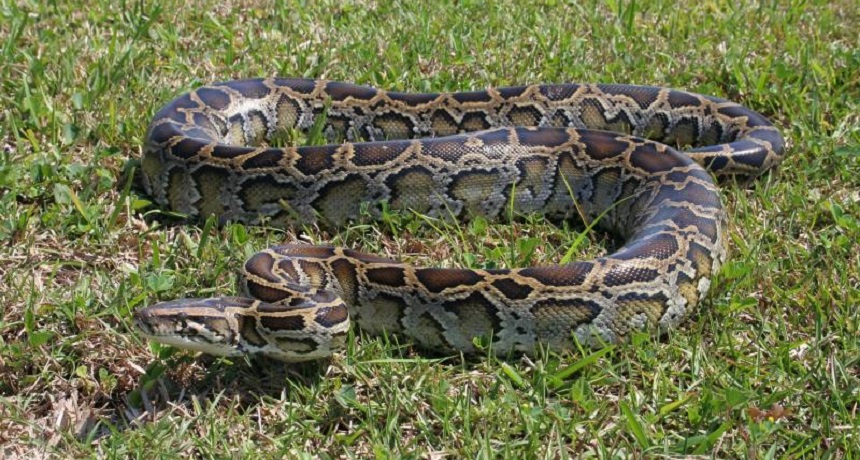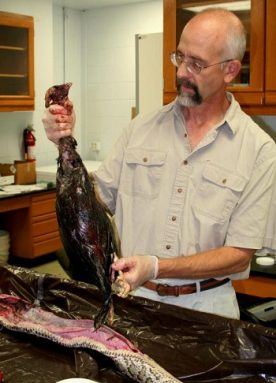News Brief: Rabbit-hunting pythons are altering Everglades
Invasive Burmese pythons are gobbling up native mammals

Burmese pythons, like the one shown here, are breeding in South Florida — especially the Everglades. To fuel their growth, the snakes are dining heavily on native mammals.
National Park Service
By Susan Milius
Even breeding like bunnies can’t save some mammals in Florida’s Everglades National Park from the invading Burmese pythons.
When summer heats up, these snakes become more active. And in a new study, they started eating marsh rabbits in alarming numbers. Each week, the snakes there were gobbling up to one in every five bunnies in some test areas, scientists now report. Over the long term, losing those once-abundant rabbits at this rate is “not even close to sustainable,” says Robert McCleery. He’s a biologist at the University of Florida in Gainesville.
This is the best evidence yet that the non-native pythons really could wipe out populations of a famously fast-breeding mammal, he says. McCleery’s team described its new findings March 18 in Proceedings of the Royal Society B.
Three years ago, scientists warned that pythons seemed to be cutting the numbers of rabbits, raccoons, opossums and many other mammals in the Florida Everglades. Mammal numbers were crashing at the same time that python populations were booming. But timing alone could not prove that the snakes were to blame.
Indeed, McCleery at first doubted that pythons by themselves could do so much damage. But the new data has this mammal ecologist really worried about how snakes are changing the Everglades.

The pythons are native to Southeast Asia. They were imported to the United States for the pet trade. But many grow too big for pet owners to manage and it appears some owners just released their pets. Today, as many as a quarter million pythons may live in South Florida.
The pythons’ size and life history certainly give these snakes an advantage. The snakes can reach reproductive age within 5 years and live to age 30 or so. By adulthood, these muscular snakes can tip the scales at more than 200 pounds (90.7 kilograms) and span more than 20 feet (6.1 meters) in length. Although these snakes can take down and ingest prey as big as a small deer, adult pythons don’t need to eat often. When prey become scarce, the snakes just rest quietly and wait for the next meal to become available — even if it takes up to a year. Oh, and hungry Burmese pythons can swim to hunt on off-shore islands.
For their new study, McCleery and his colleagues monitored the fates of 80 marsh rabbits. They introduced some into very snaky places inside the national park. They released others into zones with few pythons.
The researchers looked for carcasses of the rabbits and determined what kind of predator had killed them. In 17 cases, researchers knew a python was the killer because the dead rabbit’s tracking signal was coming from inside the python’s body.
“If you had called me halfway through the study, I would have said, “Yeah, there are some pythons out here, but it’s not that big a problem,” McCleery says. But “then it got hot. And it got wet.” In no time, he says, “rabbits disappeared.” The most likely explanation is that the snakes warmed up and started hunting more.
Snakes don’t keep their bodies at a steady temperature as people do. Instead snakes chill down and heat up with their surroundings. So when the summer heat arrives, snakes become less sluggish and can rev up the pace of their hunting.
By examining rabbit carcasses in the wild, the ecologists found mammals had been the top predators in python-poor zones. But pythons were responsible for more than two-thirds of the dead rabbits in snake-rich zones. “We’re talking about a total switch of predators,” McCleery says.
Pythons don’t limit their diet to rabbits. This means that they may also be a major cause of dwindling populations of other mammals, such as opossums and raccoons, their new study says.
Power Words
(for more about Power Words, click here)
carcass The body of a dead animal.
ecology A branch of biology that deals with the relations of organisms to one another and to their physical surroundings. A scientist who works in this field is called an ecologist.
Everglades Short for Everglades National Park, this site was established in 1947 as a federally protected wetlands area. At almost 2,500 square miles (6,070 square kilometers) in size, it is the largest subtropical wilderness in the United States. Owing to its unique nature, it is also considered a World Heritage Site. Best known for its alligators, this park is almost gaining notoriety as the home for several reproducing species of alien giant snakes, most notably the Burmese python.
habitat The area or natural environment in which an animal or plant normally lives, such as a desert, coral reef or freshwater lake. A habitat can be home to thousands of different species.
mammal A warm-blooded animal distinguished by the possession of hair or fur, the secretion of milk by females for feeding the young, and (typically) the bearing of live young.
predator (adjective: predatory) A creature that preys on other animals for most or all of its food.
prey Animal species eaten by others.
python A large, heavy-bodied, nonpoisonous constrictor snake.
sustainability (n: sustainable) To use resources in a way that they will continue to be available in the future.







